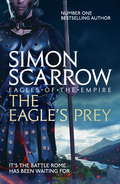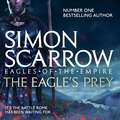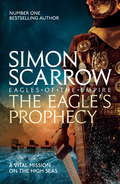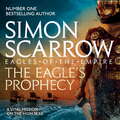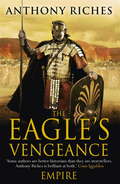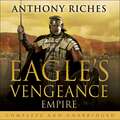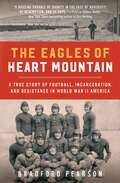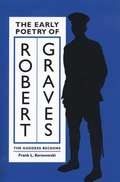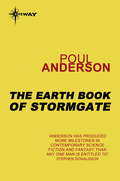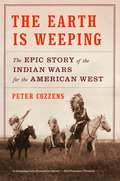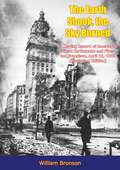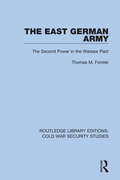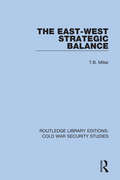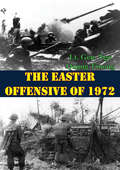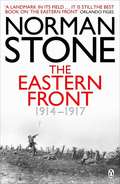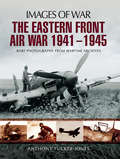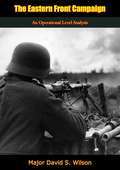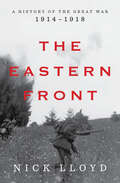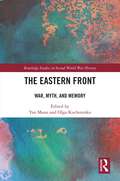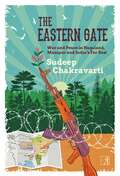- Table View
- List View
The Eagle's Prey (Eagles of the Empire 5)
by Simon ScarrowIF YOU DON'T KNOW SIMON SCARROW, YOU DON'T KNOW ROME!THE EAGLE'S PREY is the thrilling fifth novel in Simon Scarrow's bestselling Eagles of the Empire series. A must read for fans of Bernard Cornwell and Conn Iggulden. Praise for Simon Scarrow's gripping historical novels: 'Ferocious and compelling' Daily ExpressBritannia, AD 44. The time has come to claim Britain for the Empire. Centurions Cato and Macro are preparing for what their leaders say will be the final battle against those natives refusing to accept the civilising force of Rome. The British savages will surely stand no chance against the might of the unstoppable Roman army.But young Cato is more concerned about hot-headed cohort commander, Maximius, than about the enemy, and with Roman troops being brutally slaughtered, even grizzled veteran Macro is having doubts about the promised ease of their success. Will they be victorious - or will the battle cost both of them more than they could ever imagine?
The Eagle's Prey: Cato & Macro: Book 5 (Eagle #25)
by Simon ScarrowTHE EAGLE'S PREY is the thrilling fifth novel in Simon Scarrow's bestselling Eagles of the Empire series. A must read for fans of Bernard Cornwell and Conn Iggulden.It is late summer 44 AD and the battle-weary Roman legions are in their second year of campaigning against the British tribes. The troops' commander, General Plautius, is under pressure from the Emperor to crush the natives once and for all. Centurions Macro and Cato are with the crack Second Legion under the precarious leadership of Centurion Maximus and it's their task to hold a ford across the river Tamesis when the natives are forced into a trap. But Maximus's nerve breaks at the critical point, allowing the enemy leader, Caratacus, and his men to escape.Outraged by this failure, General Plautius orders the decimation of the unit. Their choice: die, or escape to become a fugitive pursued by soldiers of their own ruthless army. Hiding from their former comrades, as well as the Britons, Cato's small band of fugitives have only one chance to redeem themselves before they are hunted down like animals...(P)2017 Headline Publishing Group Limited
The Eagle's Prophecy (Eagles of the Empire 6)
by Simon ScarrowIF YOU DON'T KNOW SIMON SCARROW, YOU DON'T KNOW ROME!THE EAGLE'S PROPHECY is the powerful sixth novel in Simon Scarrow's bestselling Eagles of the Empire seires. Perfect for fans of Bernard Cornwell. Praise for Simon Scarrow's gripping novels: 'Ferocious and compelling' Daily Express The Adriatic Sea, AD 45. Cato and Macro, centurions of the Roman army, are horrified to learn that they face possible execution after the death of their commanding officer. Fortunately, the Emperor's secretary is willing to offer them an alternative: to join the marines and hunt down a band of brutal pirates who are decimating not only Rome's reputation, but also a critical supply chain.As they discover the true horror of battle at sea, Macro and Cato must also remember their real mission: to recover from those pirates a set of scrolls that hold secrets vital to the future of the Roman Empire. Rome will do anything to get them back...
The Eagle's Prophecy (Eagles of the Empire 6)
by Simon ScarrowIF YOU DON'T KNOW SIMON SCARROW, YOU DON'T KNOW ROME!THE EAGLE'S PROPHECY is the powerful sixth novel in Simon Scarrow's bestselling Eagles of the Empire seires. Perfect for fans of Bernard Cornwell. Praise for Simon Scarrow's gripping novels: 'Ferocious and compelling' Daily Express The Adriatic Sea, AD 45. Cato and Macro, centurions of the Roman army, are horrified to learn that they face possible execution after the death of their commanding officer. Fortunately, the Emperor's secretary is willing to offer them an alternative: to join the marines and hunt down a band of brutal pirates who are decimating not only Rome's reputation, but also a critical supply chain.As they discover the true horror of battle at sea, Macro and Cato must also remember their real mission: to recover from those pirates a set of scrolls that hold secrets vital to the future of the Roman Empire. Rome will do anything to get them back...
The Eagle's Prophecy: Cato & Macro: Book 6 (Cato & Macro #6)
by Simon ScarrowIF YOU DON'T KNOW SIMON SCARROW, YOU DON'T KNOW ROME!THE EAGLE'S PROPHECY is the powerful sixth novel in Simon Scarrow's bestselling Eagles of the Empire seires. Perfect for fans of Bernard Cornwell. Praise for Simon Scarrow's gripping novels: 'Ferocious and compelling' Daily Express The Adriatic Sea, AD 45. Cato and Macro, centurions of the Roman army, are horrified to learn that they face possible execution after the death of their commanding officer. Fortunately, the Emperor's secretary is willing to offer them an alternative: to join the marines and hunt down a band of brutal pirates who are decimating not only Rome's reputation, but also a critical supply chain.As they discover the true horror of battle at sea, Macro and Cato must also remember their real mission: to recover from those pirates a set of scrolls that hold secrets vital to the future of the Roman Empire. Rome will do anything to get them back...(P)2012 Headline Publishing Group Ltd
The Eagle's Vengeance: Empire VI (Empire Ser. #6)
by Anthony Riches'A master of the genre' The TimesThe Tungrian auxiliary cohorts return to Hadrian's Wall after their successful Dacian campaign, only to find Britannia in chaos. The legions are overstretched, struggling to man the forts of the northern frontier in the face of increasing barbarian resistance. The Tungrians are the only soldiers who can be sent into the northern wastes, far beyond the long abandoned wall built by Antoninus, where a lost symbol of imperial power of the Sixth Victorious Legion is reputed to await them. Protected by an impassable swamp and hidden in a fortress atop a high mountain, the eagle of the Sixth legion must be recovered if the legion is to survive. Marcus and his men must penetrate the heart of the enemy's strength, ghosting through a deadly wilderness patrolled by vicious huntresses before breaching the walls of the Fang, an all-but-impregnable fort, if they are to rescue the legion's venerated standard. If successful their escape will be twice as perilous, with the might of a barbarian tribe at their heels.
The Eagle's Vengeance: Empire VI (Empire series #6)
by Anthony RichesThe barbarian leader Calgus defies both his barbarian captors and Britannia's legions - and Marcus Aquila - once more in the sixth thrilling novel in the Empire sequence, praised by fellow-authors Conn Iggulden, Ben Kane and Manda Scott.The Tungrian auxiliary cohorts return to Hadrian's Wall after their successful Dacian campaign, only to find Britannia in chaos. The legions are overstretched, struggling to man the forts of the northern frontier in the face of increasing barbarian resistance. The Tungrians are the only soldiers who can be sent into the northern wastes, far beyond the long abandoned wall built by Antoninus, where a lost symbol of imperial power of the Sixth Victorious Legion is reputed to await them. Protected by an impassable swamp and hidden in a fortress atop a high mountain, the eagle of the Sixth legion must be recovered if the legion is to survive. Marcus and his men must penetrate the heart of the enemy's strength, ghosting through a deadly wilderness patrolled by vicious huntresses before breaching the walls of the Fang, an all-but-impregnable fort, if they are to rescue the legion's venerated standard. If successful their escape will be twice as perilous, with the might of a barbarian tribe at their heels.(P)2013 Hodder & Stoughton Limited
The Eagle's Vengeance: Empire Vi Special Sales (Empire series #6)
by Anthony Riches'A master of the genre' The TimesThe Tungrian auxiliary cohorts return to Hadrian's Wall after their successful Dacian campaign, only to find Britannia in chaos. The legions are overstretched, struggling to man the forts of the northern frontier in the face of increasing barbarian resistance. The Tungrians are the only soldiers who can be sent into the northern wastes, far beyond the long abandoned wall built by Antoninus, where a lost symbol of imperial power of the Sixth Victorious Legion is reputed to await them. Protected by an impassable swamp and hidden in a fortress atop a high mountain, the eagle of the Sixth legion must be recovered if the legion is to survive. Marcus and his men must penetrate the heart of the enemy's strength, ghosting through a deadly wilderness patrolled by vicious huntresses before breaching the walls of the Fang, an all-but-impregnable fort, if they are to rescue the legion's venerated standard. If successful their escape will be twice as perilous, with the might of a barbarian tribe at their heels.
The Eagles of Heart Mountain: A True Story of Football, Incarceration, and Resistance in World War II America
by Bradford PearsonThe impeccably researched, deeply moving, never-before-told tale about a World War II incarceration camp in Wyoming and its extraordinary high school football team—for fans of The Boys in the Boat and The Storm on Our Shores. In the spring of 1942, the United States government forced 120,000 Japanese Americans from their homes in California, Oregon, Washington, and Arizona and sent them to incarceration camps across the West. Nearly 14,000 of them landed on the outskirts of Cody, Wyoming, at the base of Heart Mountain. Behind barbed wire fences, they faced racism, cruelty, and frozen winters. Trying to recreate comforts from home, many established Buddhist temples and sumo wrestling pits. Kabuki performances drew hundreds of spectators—yet there was little hope. That is, until the fall of 1943, when the camp&’s high school football team, the Eagles, started its first season and finished it undefeated, crushing the competition from nearby, predominantly white high schools. Amid all this excitement, American politics continued to disrupt their lives as the federal government drafted men from the camps for the front lines—including some of the Eagles. As the team&’s second season kicked off, the young men faced a choice to either join the Army or resist the draft. Teammates were divided, and some were jailed for their decisions. The Eagles of Heart Mountain honors the resilience of extraordinary heroes and the power of sports in a sweeping and inspirational portrait of one of the darkest moments in American history.
The Earl J. Hess Fortifications Trilogy, Omnibus E-book
by Earl J. HessThis three-volume Omnibus e-Book set is a collection of Earl J. Hess's definitive works on trench warfare during the Civil War. The set includes:Field Armies and Fortifications in the Civil War: The Eastern Campaigns, 1861-1864, covering the eastern campaigns, from Big Bethel and the Peninsula to Chancellorsville, Gettysburg, Charleston, and Mine Run;Trench Warfare under Grant and Lee: Field Fortifications in the Overland Campaign, covering Wilderness, Spotsylvania, North Anna, Cold Harbor, and Bermuda Hundred; andIn the Trenches at Petersburg: Field Fortifications and Confederate Defeat, recounting the strategic and tactical operations in Virginia during the last ten months of the Civil War, when field fortifications dominated military planning and the landscape of battle.This invaluable trilogy is a must have for anyone interested in the battles, tactics and strategies of both sides during the Civil War.
The Early Anglo-Saxon Kings
by Tony SullivanThe book takes a new look at the archaeological and literary evidence and focuses on the fragmenting Diocese, provincial and civitas structures of post-Roman Britain. It places events in the context of increased Germanic immigration alongside evidence for significant continuation of population and land use. Using evidence from fifth century Gaul it demonstrates dynamic changes to cultural identities both within and across various groups. Covering the migration period it describes the foundation stories of Hengest and Horsa in Kent, Cerdic and Cynric, first kings of the West Saxons and Ælle founder of the kingdom of the South Saxons. Ælle is the first king Bede describes as holding imperium and the Anglo-Saxon Chronicle calls Bretwalda. Covering the figures of Ceawlin, Æthelberht and Rædwald it ends with the death of Penda, the last great pagan king. As life under Roman authority faded into history we see the emergence of a ‘warband’ culture and the emergence of petty kingdoms. The mead hall replaced crumbling villas and towns as the center of social life. These halls rang with the poems of bards and the stories of great warriors and battles. Arthur and Urien of Rheged. The famous Mons Badonicus and the doomed charge of the Gododdin at Catraeth. A chapter on weapons, armor, warfare and accounts of contemporary battles will help paint a picture of dark age warfare. From the arrival of Saxon mercenaries in the fifth century to the death of Penda, the last pagan king, at Winwaed in 655.
The Early Poetry of Robert Graves: The Goddess Beckons
by Kersnowski Frank L.Like many men of his generation, poet Robert Graves was indelibly marked by his experience of trench warfare in World War I. The horrific battles in which he fought and his guilt over surviving when so many perished left Graves shell-shocked and disoriented, desperately seeking a way to bridge the rupture between his conventional upbringing and the uncertainties of postwar British society. In this study of Graves's early poetry, Frank Kersnowski explores how his war neurosis opened a door into the unconscious for Graves and led him to reject the essential components of the Western idea of reality—reason and predictability. In particular, Kersnowski traces the emergence in Graves's early poems of a figure he later called "The White Goddess," a being at once terrifying and glorious, who sustains life and inspires poetry. Drawing on interviews with Graves's family, as well as unpublished correspondence and drafts of poems, Kersnowski argues that Graves actually experienced the White Goddess as a real being and that his life as a poet was driven by the purpose of celebrating and explaining this deity and her matriarchy.
The Earth Book of Stormgate: A Polesotechnic League Book (POLESOTECHNIC LEAGUE)
by Poul Anderson'Behold these annals from the Discovery and on through the World-Taking.This is the tale as told by Terrans, who walk the earth.Then read.'THE EARTH BOOK OF STORMGATE POUL ANDERSON'S MIGHTY EPIC OF FUTURE HISTORYThe full length story forming the core of the chronicle of the expansion of earthmen into the inhabited galaxy . . . from the Earth Book kept in the Stormgate archive of the great winged race of Ythri.
The Earth Is Weeping: The Epic Story of the Indian Wars for the American West
by Peter CozzensBringing together a pageant of fascinating characters including Custer, Sherman, Grant, and a host of other military and political figures, as well as great native leaders such as Crazy Horse, Sitting Bull, Geronimo, and Red Cloud, The Earth is Weeping—lauded by Booklist as “a beautifully written work of understanding and compassion”—is the fullest account to date of how the West was won…and lost."[S]ets a new standard for Western Indian Wars history..." —Stuart Rosebrook, True West MagazineWith the end of the Civil War, the nation recommenced its expansion onto traditional Indian tribal lands, setting off a wide-ranging conflict that would last more than three decades. In an exploration of the wars and negotiations that destroyed tribal ways of life even as they made possible the emergence of the modern United States, Peter Cozzens gives us both sides in comprehensive and singularly intimate detail. He illuminates the encroachment experienced by the tribes and the tribal conflicts over whether to fight or make peace, and explores the squalid lives of soldiers posted to the frontier and the ethical quandaries faced by generals who often sympathized with their native enemies.
The Earth Shook, the Sky Burned: A Moving Record of America’s Great Earthquake and Fire: San Francisco, April 18, 1906 [Illustrated Edition]
by William BronsonThe Earth Shook, The Sky Burned is the dramatic, complete account of the San Francisco earthquake of April 18, 1906. In the early morning of that day, the sleeping city was rocked by a violent earth tremor that ravaged buildings, heaved streets, and terrified drowsy residents. But worse was to come: the devastating fire that swept across the city for three days. Nearly 30,000 structures were destroyed, and over a quarter million people were left homeless.The Earth Shook, The Sky Burned is a blow-by-blow account of the four days of devastation, not only in San Francisco, but in its adjacent communities. Among the huge cast are Enrico Caruso, who vowed never to return after the quake; John Barrymore, reportedly shaken from a tryst with a young actress; General Frederick Funston, who directed attempts to halt the spreading fire; and Amadeo Giannini, who saved the Bank of Italy’s gold reserves in his horsecart and founded Bank of America after the fire.Illustrated with over 400 on-the-scene photographs, this memorable book reflects the indomitable spirit and vigor of the people who built the West.“Bronson covers every aspect of the disaster in lucid sinewy prose and the selection of a brilliant gallery of pictures…This must rank as the most moving and comprehensive account of the great disaster ever published.”—Los Angeles Times“A fascinating book, and the pictures are magnificent.”—Chicago Sunday Tribune“The Earth Shook, The Sky Burned will make you quake in your boots. The extraordinary story that began on April 18, 1906, has never been told better than what you will find between these covers.”—Michael McCone, Executive Director, The California Historical Society
The East German Army: The Second Power in the Warsaw Pact (Routledge Library Editions: Cold War Security Studies #23)
by Thomas M. ForsterThis book, first published in 1980, provides a detailed analysis of the East German army in the last decade of the Cold War. It examines the capabilities of the main force, after the Soviet army, in the Soviet Bloc, and shows how it depended on more things than purely military factors and national policies. It focuses the army as part of a society that had been comprehensively militarized through ‘socialist military education’, and shows that it was closely tied to the Soviet army, with no military doctrine of its own. In this way, this book provides an analysis of not just East German domestic policies, over which its army held great sway, but also of Soviet Bloc strategic planning for conflict in Western Europe.
The East-West Strategic Balance (Routledge Library Editions: Cold War Security Studies #24)
by T.B. MillarThis book, first published in 1981, offers an analysis of the ways in which one strategic situation in Cold War politics impinged on another, and the interplay of historical forces and trends shaping national policies and the world pattern of power. Bringing together a wealth of factual and analytical material about the alliance systems built around the two superpowers, it examines the areas that seem most dangerous to the peace of the world, particularly in the Middle East, Asia and Latin America.
The Easter Offensive Of 1972 (Indochina Monographs #5)
by Lt. Gen. Ngo Quang TruongIncludes over 30 maps and illustrationsThis monograph forms part of the Indochina Monograph series written by senior military personnel from the former Army of the Republic of Vietnam who served against the northern communist invasion."In 1968, a U.S. presidential election year, Communist North Vietnam initiated the Tet Offensive, striking at almost all major cities and towns of South Vietnam. This general offensive was eventually defeated by the collective efforts of the Republic of Vietnam, United States and Free World Assistance forces. Four years later, in 1972--again a U.S. presidential election year--North Vietnam threw its entire military might behind an invasion to conquer the South. This time, however, South Vietnam had to fight for survival with only logistics and combat support provided by the United States. Almost all U.S. and Free World Military Assistance combat forces had been withdrawn when the first attacks began on 30 April 1972.By all standards, the Easter Offensive of 1972 was one of North Vietnam's most significant initiatives during the Vietnam War. This all-out effort involved eventually in excess of ten divisions on each side and affected the lives of well over a million South Vietnamese people. During the eight long months of fierce fighting, the Republic of Vietnam Armed Forces put Vietnamization to a severe test.During the period of the Easter Offensive, I had the privilege of participating in some of its major battles, first as IV Corps and then as I Corps commander beginning in early May 1972. I visited many of our combat units as they fought the North Vietnam Army and commanded the RVNAF counteroffensive to retake Quang Tri City. My critical analysis of the enemy 1972 Easter Invasion, therefore, is based almost exclusively on my own personal observations, impressions and interviews with Vietnamese who were directly involved."-Authors' Preface.
The Eastern Fleet and the Indian Ocean, 1942–1944: The Fleet that Had to Hide
by Charles StephensonThe story of the British Eastern Fleet, which operated in the Indian Ocean against Japan, has rarely been told. Although it was the largest fleet deployed by the Royal Navy prior to 1945 and played a vital part in the theater it was sent to protect, it has no place in the popular consciousness of the naval history of the Second World War. So Charles Stephenson’s deeply researched and absorbing narrative gives this forgotten fleet the recognition it deserves. British prewar naval planning for the Far East is part of the story, as is the disastrous loss of the battleship Prince of Wales and battlecruiser Repulse in 1941, but the body of the book focuses on the new fleet, commanded by Admiral Sir James Somerville, and its operations against the Japanese navy and aircraft as well as Japanese and German submarines. Later in the war, once the fleet had been reinforced with an American aircraft carrier, it was strong enough to take more aggressive actions against the Japanese, and these are described in vivid detail. Charles Stephenson’s authoritative study should appeal to readers who have a special interest in the war with Japan, in naval history more generally and Royal Navy in particular.
The Eastern Front 1914-1917
by Norman Stone'Without question one of the classics of post-war historical scholarship, Stone's boldly conceived and brilliantly executed book opened the eyes of a generation of young British historians raised on tales of the Western trenches to the crucial importance of the Eastern Front in the First World War' Niall Ferguson 'Scholarly, lucid, entertaining, based on a thorough knowledge of Austrian and Russian sources, it sharply revises traditional assumptions about the First World War.' Michael Howard
The Eastern Front Air War, 1941–1945: Rare Photographs From Wartime Archives (Images of War)
by Anthony Tucker-JonesThis lavishly illustrated WWII history examines the bitter aerial combat of the Eastern Front through rare wartime photographs and informative text. Though the air war was a major aspect of the Eastern Front conflict, it has long been neglected by historians. Anthony Tucker-Jones&’s photographic history offers a vividly detailed introduction to the subject. With more than 150 archival images—most of which have never been published before—this volume examines Stalin&’s Red Air Force and Hitlers Luftwaffe, their equipment, and the role they played in supporting the war on the ground. Just before Hitler&’s invasion of the Soviet Union, Stalin had decimated the leadership of the Red Air Force in a series of purges. Thousands of Russian fighter aircraft were swiftly destroyed in the German Blitzkrieg. But a remarkable recovery followed as the Red Air Force turned the tide against the ravages of the Luftwaffe to wrestle back air superiority by 1944.
The Eastern Front Campaign: An Operational Level Analysis
by Major David S. WilsonThe Eastern Front, 1941-1945, is one of the biggest and most decisive theaters of operation in modern history, and was the largest theater of war in World War Two. A total force of 9 million Germans and Russians battled on both sides with a combined strength of 590 divisions. Military losses approached 5 million German casualties, and 17 million Russian casualties. Altogether, both sides had an active strength of 13,000 tanks, 18,000 combat aircraft, and 50,000 artillery pieces. With the exception of the massive Allied Combined bombing campaign, the Allied effort of ninety-three divisions in Western Europe against seventy German division pales in comparison.Another interesting point in the Eastern Front was initial nature of German operational maneuver, followed by the evolution of Russian operational maneuver. By 1944, the Russian Army had become experts on operational maneuver, and maximized the principals of war of mass, objective, offense, and maneuver. The German Army against an army four times its size eventually culminated, but not until after four years of intense fighting. Eighty percent of total German casualties were lost on the Eastern front, 4.7 million of 6 million casualties. Further, both sides lost an estimated 65,000 tanks and 60,000 combat aircraft, two-thirds being Russian.The methodology of this analysis is chronological, based on the successive operational campaigns from June 1941 through May 1945. Each campaign lists the order of battle, and then the combat power using Lanchester equations (Frederich W. Lanchester) of military combat. In studying modern war, the Eastern Front is a case study in a maneuver oriented army versus a large attrition based army. With almost six hundred years’ worth of German divisional combat on the Eastern Front, valuable lessons can be learned in studying this theater of war.
The Eastern Front: A History of the Great War, 1914-1918
by Nick LloydThe first major history in fifty years of the often overlooked Eastern Front of the First World War, where a more fluid conflict resulted in the destruction of great empires and the rise of the Soviet Union. <P><P> Writing in the 1920s, Winston Churchill argued that the First World War on the Eastern Front was “incomparably the greatest war in history. In its scale, in its slaughter, in the exertions of the combatants, in its military kaleidoscope, it far surpasses by magnitude and intensity all similar human episodes.” It was, he concluded, “the most frightful misfortune” to fall upon mankind “since the collapse of the Roman Empire before the Barbarians.” Yet Churchill was an exception, and the war in the east has long been seen as a sideshow to the brutal combat on the Western Front. Finally, with The Eastern Front—the first major history of that arena in fifty years—the acclaimed historian Nick Lloyd corrects the record. <P><P> Drawing on the latest scholarship as well as eyewitness reports, diary entries, and memoirs, Lloyd moves from the great battles of 1914 to the final collapse of the Central Powers in 1918, showing how a local struggle between Austria-Hungary and Serbia spiraled into a massive conflagration that pulled in Germany, Russia, Italy, Romania, and Bulgaria. The Eastern Front was a vast theater of war that brought about the collapse of three empires and produced almost endless suffering. As many as sixteen million soldiers and two million civilians were killed or wounded in enormous battles that took place across as much as one hundred kilometers. Unlike in the west, where stalemate ruled the day, the war in the east was fluid, with armies embarking on penetrating advances. Lloyd narrates the repeated invasions of Serbia as well as the great battles between Russian, German, and Austrian forces at Tannenberg, Komarów, Gorlice–Tarnów, and the Masurian Lakes. All along, he takes us into the strategy of the generals who decided the war’s course, from the Germans Ludendorff and Hindenburg to the Austro-Hungarian chief, Conrad von Hötzendorf, to the brilliant Russian Brusilov. <P><P> Perhaps the most radical aspect of the struggle in the east was that the violence was not confined to combatants. The Eastern Front witnessed calculated attacks against civilians that ripped the ethnic and religious fabric of numerous societies, paving the way for the horrors of the Holocaust. Lloyd’s magisterial, definitive account of the war in the east will fundamentally alter our understanding of the cataclysmic events that reshaped Europe and the world. <p> <b>New York Times Bestseller</b>
The Eastern Front: War, Myth, and Memory (Routledge Studies in Second World War History)
by Olga Kucherenko Yan MannThe Second World War in Eastern Europe is far from a neglected topic, especially since social, cultural, and diplomatic historians have entered a field previously dominated by operational histories, and produced a cornucopia of new scholarship offering a more nuanced picture from both sides of the front. However, until now, the story has still been disjointed and specialized, whereby military, social, economic, and diplomatic histories continue to give their own separate accounts. This collection of essays attempts to bring these themes into a more cohesive whole that tells a complex, multifaceted story of war on the Eastern Front as it truly was.This is one of the few critical examinations that includes both perspectives and looks at the war as a multi‑front effort. It also reveals how myths are created around military conflicts and have direct relevance to current developments in Europe, linking them to a broader discussion of the Second World War, its impact and utility today. It gives a historical dimension to pressing issues and will be of interest and relevance to history students, policymakers, political scientists, diplomats, and foreign policy experts.The Eastern Front will be a useful reference source, since some chapters rely on extensive new archival research and materials, ego sources, as well as extensive findings of non‑Western scholars, thereby bringing their work to the attention of a broader audience.
The Eastern Gate: War and Peace in Nagaland, Manipur and India's Far East
by Sudeep ChakravartiTraders, Pushers, Soldiers, Spies.A pivot for India&’s Act-East policy. The gateway to a future of immense possibilities from hydrocarbons to regional trade over land and water that could create a new Silk Route. A bulwark against China. A cradle of climate change dynamics and migration. &‘Northeast&’ India, the appellation with which India&’s far-east is known, is all this and more.Alongside hope and aspiration, it is also home to immense ethnic and communal tension, and a decades-old Naga conflict and the high-profile peace process that involves four gateway states—Nagaland, Manipur, Arunachal Pradesh and Assam—and several million people. It&’s among the most militarized zones in the world. It&’s a playground of corruption and engineered violence. Only real peace, and calm in both Myanmar and Bangladesh, will unlock this Eastern gate.A keen observer and frequent chronicler of the region, Sudeep Chakravarti has for several years offered exclusive insights into the Machiavellian—Chanakyan—world of the Naga and other conflicts and various attempts to resolve these. He now melds the skills of a journalist, analyst, historian and ethnographer to offer inside stories and a ringside view to the tortuous, no-holds-barred attempts at resolving conflict.Employing a &‘dispatches&’ style of storytelling, and interviews with rebel leaders, politicians, bureaucrats, policymakers, security specialists and operatives, gunrunners, &‘narcos&’, peace negotiators and community leaders, Chakravarti&’s narrative provides a definitive guide to the transition from war to peace, even as he keeps a firm gaze on the future. The Eastern Gate is a tour de force that captures this story of our times.
